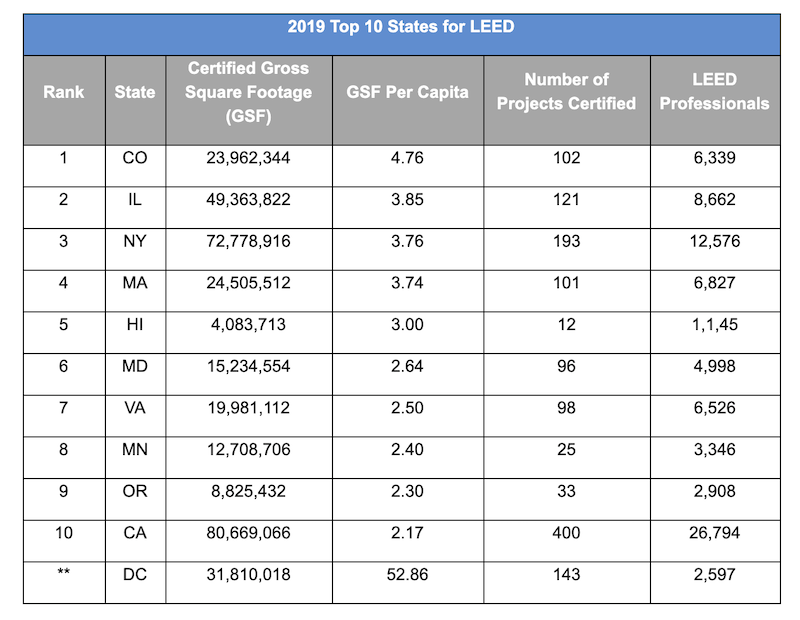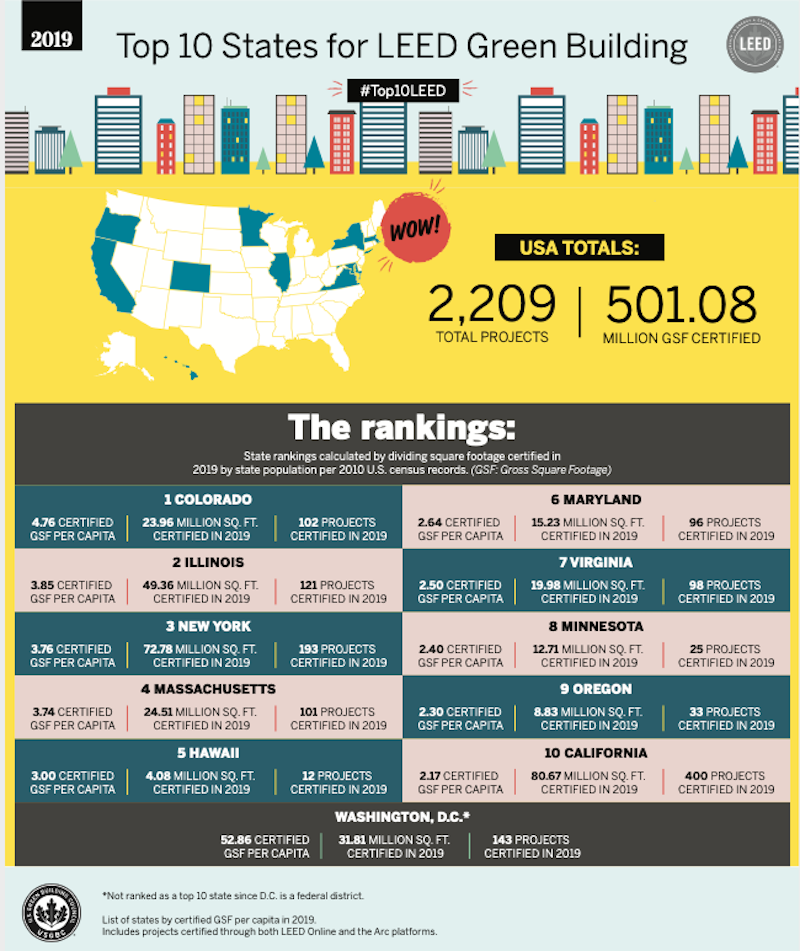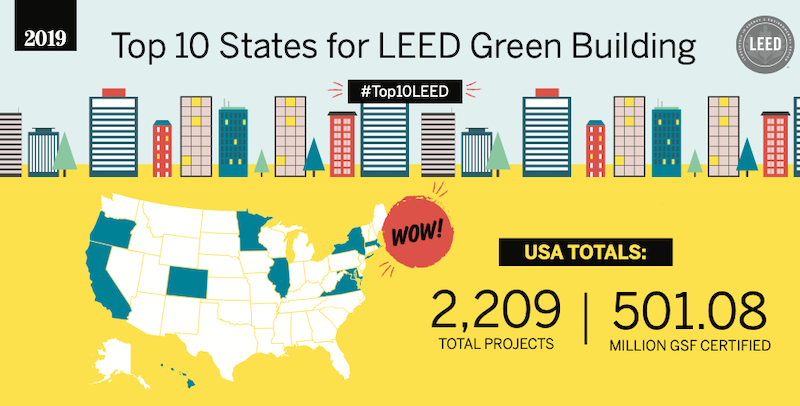As cities and states continue to work toward climate action goals, the U.S. Green Building Council (USGBC) has announced its list of Top 10 States for LEED green building. For the first time since 2011, Colorado took the top spot on the list, which ranks states based on the number of LEED certified square feet per person. LEED, or Leadership in Energy and Environmental Design, is the most widely used green building rating system in the world with more than 100,000 projects engaged. This year’s top states are home to more than 105 million people, including more than 80,000 LEED green building professionals with the skills to support the sustainable transformation of buildings.
“As we embark on a new decade, the USGBC community is focused on helping more projects get on the path to LEED certification and a more sustainable future,” said Mahesh Ramanujam, president and CEO, USGBC. “Over the last year, the Top 10 states have certified projects that serve as incredible examples of how green building can create more sustainable and resilient spaces that improve our living standard. There is still much work to be done, but the progress made across these states shows us that our work is having a tangible impact on people’s lives. As we enter our next chapter, we are committed to helping more buildings, cities and communities improve their sustainability performance through LEED.”
LEED-certified projects support personal health and well-being, as well as use less energy and water, reduce carbon emissions and save money for families, businesses and taxpayers. The Top 10 list is based on 2010 U.S. Census data and includes commercial and institutional green building projects certified throughout 2019. Colorado certified 102 green building projects representing 4.76 square feet of LEED-certified space per resident. The state has made the Top 10 list each year but jumped to the top spot after ranking sixth in 2018. Minnesota and Oregon reemerged as Top 10 states after missing the list last year, coming in at number eight and nine respectively. The full rankings are as follows:

USGBC calculates the list using per capita figures to allow for a fair comparison of the level of green building taking place among states with significant differences in population and number of overall buildings. Despite Washington, D.C. not appearing in the official Top 10 list because of its status as a federal territory, it consistently leads the nation and in 2019 certified 52.86 square feet of space per resident across 143 green building projects. The nation’s capital has a strong legacy of sustainability leadership and has expanded its use of LEED from buildings to cities and communities to support its goals. In 2017, it became the first LEED-certified city and in 2019 certified the Golden Triangle Business Improvement District LEED Platinum, the first business improvement district in the world to certify.
With green building expected to grow globally through 2021, the need for skilled professionals to support green building projects has never been more important. Across the U.S. there are more than 165,000 LEED green building professionals with the knowledge to help cities and communities transition to greener buildings and spaces. LEED professionals demonstrate a competency in green building principles that can set projects on the path to certification and help them consider ways to reduce their impact on the environment and provide people with healthier, more sustainable spaces to live, learn, work and play.

As USGBC continues to advance green buildings, cities and communities through the adoption of LEED and the latest version of the rating system, LEED v4.1, the organization is also considering a future that is focused on a more regenerative approach. In November 2019 at the annual Greenbuild International Conference & Expo, USGBC introduced LEED Positive – a roadmap that will lay the foundation for a future of LEED that transitions away from strategies that only reduce harm and instead focus on those that help repair and restore. With a continued focus on performance, USGBC is laying the groundwork to ensure sustainable design, construction and operations of buildings, cities and communities remains focused on better buildings that contribute to better lives.
Related Stories
Market Data | Apr 11, 2023
Construction crane count reaches all-time high in Q1 2023
Toronto, Seattle, Los Angeles, and Denver top the list of U.S/Canadian cities with the greatest number of fixed cranes on construction sites, according to Rider Levett Bucknall's RLB Crane Index for North America for Q1 2023.
Contractors | Apr 11, 2023
The average U.S. contractor has 8.7 months worth of construction work in the pipeline, as of March 2023
Associated Builders and Contractors reported that its Construction Backlog Indicator declined to 8.7 months in March, according to an ABC member survey conducted March 20 to April 3. The reading is 0.4 months higher than in March 2022.
Market Data | Apr 6, 2023
JLL’s 2023 Construction Outlook foresees growth tempered by cost increases
The easing of supply chain snags for some product categories, and the dispensing with global COVID measures, have returned the North American construction sector to a sense of normal. However, that return is proving to be complicated, with the construction industry remaining exceptionally busy at a time when labor and materials cost inflation continues to put pricing pressure on projects, leading to caution in anticipation of a possible downturn. That’s the prognosis of JLL’s just-released 2023 U.S. and Canada Construction Outlook.
Market Data | Apr 4, 2023
Nonresidential construction spending up 0.4% in February 2023
National nonresidential construction spending increased 0.4% in February, according to an Associated Builders and Contractors analysis of data published by the U.S. Census Bureau. On a seasonally adjusted annualized basis, nonresidential spending totaled $982.2 billion for the month, up 16.8% from the previous year.
Multifamily Housing | Mar 24, 2023
Average size of new apartments dropped sharply in 2022
The average size of new apartments in 2022 dropped sharply in 2022, as tracked by RentCafe. Across the U.S., the average new apartment size was 887 sf, down 30 sf from 2021, which was the largest year-over-year decrease.
Multifamily Housing | Mar 14, 2023
Multifamily housing rent rates remain flat in February 2023
Multifamily housing asking rents remained the same for a second straight month in February 2023, at a national average rate of $1,702, according to the new National Multifamily Report from Yardi Matrix. As the economy continues to adjust in the post-pandemic period, year-over-year growth continued its ongoing decline.
Contractors | Mar 14, 2023
The average U.S. contractor has 9.2 months worth of construction work in the pipeline, as of February 2023
Associated Builders and Contractors reported today that its Construction Backlog Indicator increased to 9.2 months in February, according to an ABC member survey conducted Feb. 20 to March 6. The reading is 1.2 months higher than in February 2022.
Industry Research | Mar 9, 2023
Construction labor gap worsens amid more funding for new infrastructure, commercial projects
The U.S. construction industry needs to attract an estimated 546,000 additional workers on top of the normal pace of hiring in 2023 to meet demand for labor, according to a model developed by Associated Builders and Contractors. The construction industry averaged more than 390,000 job openings per month in 2022.
Market Data | Mar 7, 2023
AEC employees are staying with firms that invest in their brand
Hinge Marketing’s latest survey explores workers’ reasons for leaving, and offers strategies to keep them in the fold.
Multifamily Housing | Feb 21, 2023
Multifamily housing investors favoring properties in the Sun Belt
Multifamily housing investors are gravitating toward Sun Belt markets with strong job and population growth, according to new research from Yardi Matrix. Despite a sharp second-half slowdown, last year’s nationwide $187 billion transaction volume was the second-highest annual total ever.

















